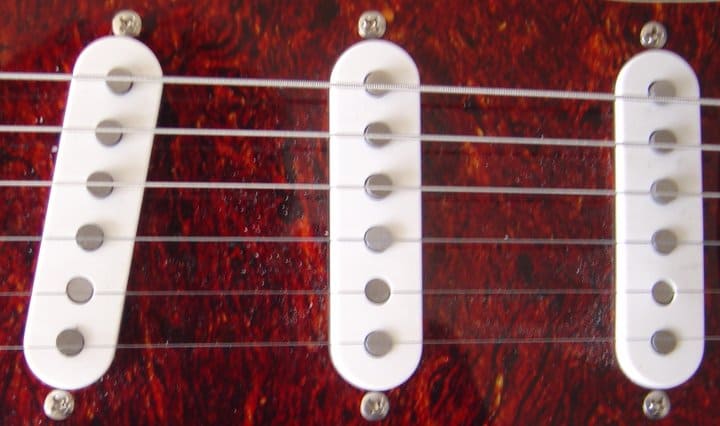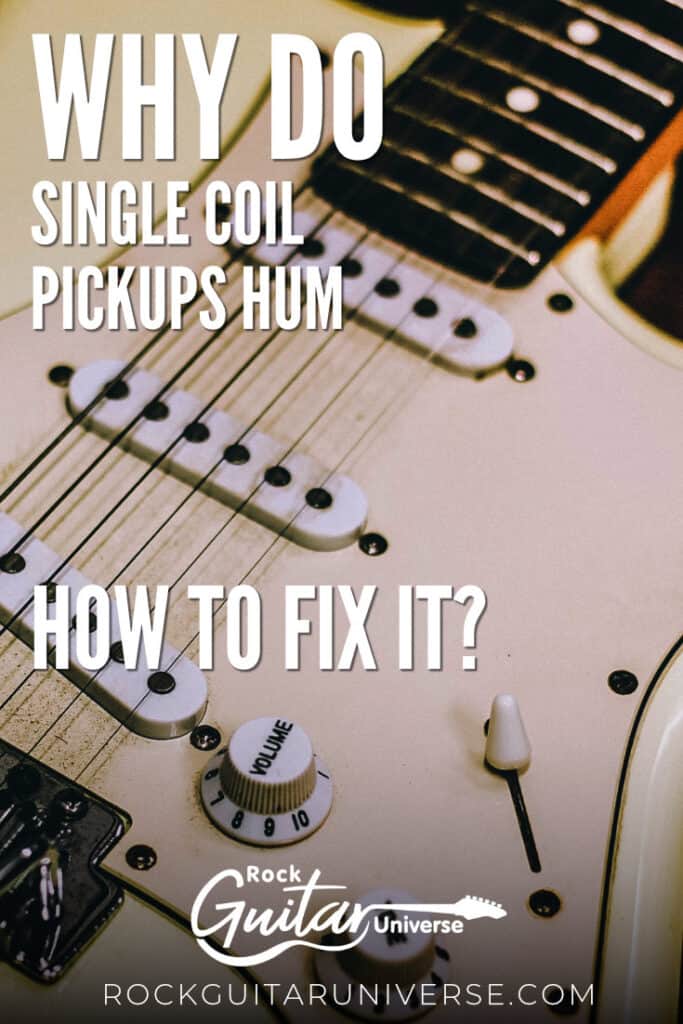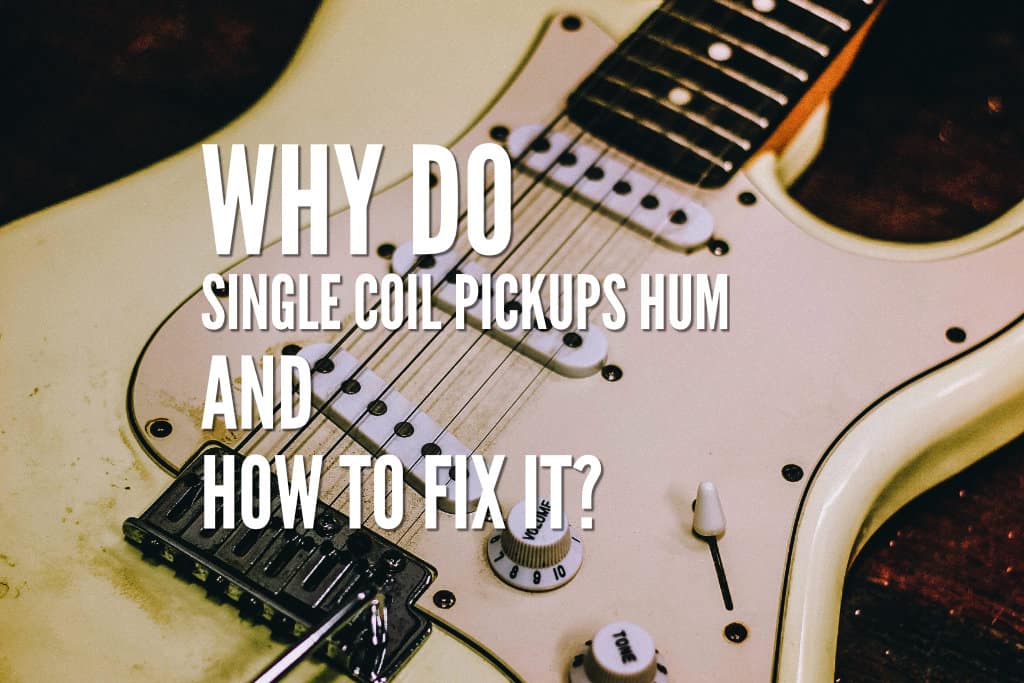For every guitar player out there, it is no secret that one of the most important elements for shaping your tone into a sweet yet powerful one is the type of pickups you will use on your guitar. It may also be no secret that the two most common types of pickups are the single coil pickup and the humbucker pickup.
You will most likely use one of the two. One of the most common issues with single coils is that even when they can provide you a great tone (brighter and crisper, with more definition between strings), the amount of unwanted noise they produce can be discouraging for anyone looking to build their tone on single coils.
So, Why do single-coil pickups hum and how can you fix it? In short, the single coils hum because their magnetic coils act as an antenna and are sensitive to external electromagnetic interference from things such as lights, TV’s, even your amplifier. The solutions to fixing the hum on single-coils:
- Shielding your pickups and guitar body
- Getting a Hum Eliminator pedal
- Getting a Noise Gate pedal
- Installing Noiseless Guitar Pickups
These solutions all have pros and cons and your decision may vary according to your particular needs. I will get into detail on these solutions so you can get a better idea of which one you should choose. In order for me to explain to you these solutions, let us first discuss a bit about single-coil pickups.
What Is A Single Coil Pickup?

In its essence, a single-coil pickup is a type of magnet that converts the vibration of the strings into an electric signal. When a string vibrates, the magnetic field of the pickup is disturbed, creating an electrical current. This electrical current is then caught and expanded by an amplifier, which goes into a speaker to create sound.
Now, if I get a bit into the technical aspects of a pickup, I have to mention that to send a stronger signal to an amplifier, the pickup has to have a higher output.
This is achieved by having a considerably greater amount of copper wirings (which is the main component of guitar pickups) within the pickup. This, in turn, will directly affect your tone, making it more mid-range and with less high frequencies.
You can also increase the strength of the electric signal by using thicker strings (higher mass of the strings) or by purchasing strings that have a higher iron content, which would excite the magnetic field in a stronger manner.
If you are interested to know more about electric guitar pickup and whatever they really matter, you can check my post Do Electric Guitar Pickups Really Make A Difference?
What Causes A Pickup To Hum?
The magnet of that a pickup is built and acts as an “antenna”. The idea is that through constant vibrations of your strings, the “antenna” will constantly pick up the main source of vibrations (your playing).
Now, the main problem is that this magnet is powerful enough to capture other sources of currents. Radiation from lighting circuits and fluorescent lights are two of the main sources of hum. Where do we find these two sources predominantly? In a stage!
The way it works is, this radiation generates electric and magnetic fields that oscillate at around 60hz. This frequency wouldn’t be that much of an issue since it is a very low one.
The real problem arises due to the fact that besides that 60hz cycle, it will also generate its harmonics. The amplifier will capture all of this and if these currents are particularly strong, hum or even a buzzing sound will be produced.
Would A Humbucker Have These Issues?
The answer is, no. A humbucker will very rarely experience any humming issues and if so, they would probably arise due to a problem with the wiring. The reason why a humbucker won’t have humming issues is that a humbucker uses two single coils instead of one.
The two single coils are wired in a way that they are out of phase and with their magnetic poles faced in opposite directions. This will effectively cancel any external noise or hum.
You might think then, that there is no reason to have single coils since they naturally come with humming issues. In reality, both single coils and humbuckers will sound very different and both give you a wide palette of sounds.
Nowadays, we can also find humbuckers that are wired to provide you with the option of making them single coiled. This will give you much more tonal options for sure!
How To Get Rid Of The Hum?
If you were to decide to stay the course with your single-coil pickups, I have put together different, effective methods to cancel or at least dramatically reduce humming and buzzing issues. Let’s get to it!
Shielding
Shielding is a very effective way of reducing the exposure a single coil would have to unwanted sources of noise. The reason I phrase it like this is that shielding will not eliminate the 60hz oscillation I mentioned before. It will simply act as a ‘cage’ for the pickup to keep it isolated from external noise.
The way this works is by creating a shield made out of copper or aluminum tape. Both of them are conductive and will harness external signal so they don’t reach the pickup magnet. You can also use shielding paint, which is made out of graphite and is also a choice. It will certainly look aesthetically better, but is more expensive and might not be worth it.
Before getting into detail on how would you go about doing this, I have to say this is a bit of a complex thing to do. If you already did some modification or maintenance to your guitar or you have some wiring and soldering skills and an understanding of the electronics in a guitar, then this DIY will be easy for you to do. However, if you haven’t even changed strings by yourself so this may be overkill for you so proceed at your own risk.
If you decided to feel confident about doing this on your own, in a more DIY way, you will need some heavy-duty aluminum foil. The aluminum foil will not have any sort of adhesive, so what I recommend is using something like a 3M Adhesive Spray.
Make sure you use a very light coat of spray since it is not conductive material. You will also need a marker to trace out your pickguard on the aluminum foil and some scissors to cut out the pieces needed.
The process is as follows:
Pickguard
- Remove the pickguard of your guitar with the appropriate screwdriver.
- Place pickguard on a big piece of aluminum foil and trace it out with a marker.
- Cut the traced pickguard of aluminum foil. Feel free to cut it into small pieces, rather than one piece if that is easier to handle.
- Do a light coat of adhesive spray on aluminum and gently place it on the side of the pickguard that will go into the guitar. Make sure there is no excess coming out of the pickguard.
- If you cut in small pieces, use a bit of aluminum foil to make sure the whole foil is connected together.
Body Of Guitar
The process for shielding the body of the guitar is as follows:
- Cut small pieces of aluminum foil and place them in the cavity of the electronics. You should think of this as making a puzzle of small fragments that will end up covering the whole cavity.
- Once that is done, take one piece at a time, apply a light coat of adhesive spray and place them back. Basically, you are redoing the puzzle.
- Once the puzzle is finished, cut four small pieces of aluminum and place them in 4 different areas as to overlap with the outside of the body (all of this can be seen on referenced video). This is so that you ensure continuity of aluminum contact between the pickguard and the body.
- Make sure to leave space unshielded where the pickups are installed with the screws, to avoid any connection issues form the screws.
- Ground electronics back into the aluminum foil of the pickguard and put the electronics back into the body. Put back the screws and you are done!
I’m adding this video as a reference to help you better understand the steps I outlined.

Hum Eliminator Pedal
- Uses 1:1 isolation transformers to break loop antenna and balance audio...
- Also converts balanced and unbalanced signals and cable types
- 1/4" smart jacks can accept any combination of mono or stereo plugs
- Passive device (No power required)
For you guitar players out there who do not wish to get into the intricacies of dismantling your guitar, shielding it and then reassembling it, this is your solution. The EBTECH Hum Eliminator is a pedal created specifically to disrupt that 60Hz cycle hum we have been talking about.
It is also a tool great to balance your signal, which will, in turn, make your sound more potent and with a clearer tone. I wouldn’t say the last bit is a good enough reason to buy it, but if your intention is to find a way to get rid of hum and buzz, this is a great option.
The Hum Eliminator comes in three different presentations. The first one is a two-channel box for ¼ inch cables (guitar cables). The second one is a two-channel box for both ¼ inch cables and XLR (used for microphones for example). The third one is an 8-channel, in case you needed more inputs.
Noise Gate Pedals
- Noise Suppress/Noise Gate Guitar Pedal
- Compact noise suppression pedal for eliminating noise and hum in guitar and...
- Unique noise detection circuit preserves the natural attack and envelope of...
- Threshold and Decay knobs allow for shaping the elimination/suppression as...
Noise gate pedals are an excellent choice for someone who not only wishes to eliminate hum but also for someone who has already experimented with creating a complete pedalboard that defines his/her unique sound.
A noise gate works by setting a limit to the volume of your sound. Once something passes that limit, the noise gate will act by reducing or muting completely your sound. A good scenario to imagine is you playing a lead line or solo.
You get to the last note, which you hold. Once the sustain of that note ends, the gate will make sure you attain complete silence without any annoying tail staying behind.
This becomes particularly important and useful once you get to that point where your ears are paying attention to what the other instruments do in a song and you wish to manipulate dynamics in a more professional manner.
How To Use A Noise Gate Pedal
Most noise gate pedals will have only 2-3 parameters to manipulate, which makes it easier for us. The one parameter you will ALWAYS find is a threshold. The threshold is the limit of sound volume you set before the gate activates.
The higher the threshold, the faster the gate will act and the greater the noise suppression will be. This is particularly helpful for rhythm guitar and it will create more space and tightness. It might not be as good for leads and solos since it might cut your sustain before you want to. If that is the case, lower the threshold and you’ll be set!
Another parameter you might find is decay. I find decay to be really useful since it gives you the possibility of deciding how fast the sound will go from where you are to zero. Think of it as a reverse swell effect and its very useful for leads. The bigger the decay, the longer it will take for the sound to reach zero.
Finally, on some pedals, you have the mode parameter, which is usually either in “reduction” or “mute”. This essentially gives you the option to decide whether you want to hear complete silence or you want your sound to still remain to enhance the vibe of the song. Not really a parameter that I consider super helpful, but if it’s in the pedal, why not?
Is It Worth Getting?
I probably wouldn’t recommend this pedal to someone who is just starting or spends most of his time playing in his/her room. Don’t get me wrong, it is a great addition to your pedal collection, but if you are just starting, I would probably spend on buying tone shaping pedals such as delays, distortions, choruses or flangers, etc…
Noiseless Single Coil Pickups
I have to say this one is probably the least effective, but at the same time might be the most interesting for you in your pursuit of tone. I’ll explain this briefly, but first, we must ask the question: What is a Noiseless Single Coil Pickup?
Interestingly enough, a noiseless single coil pickup is actually not a single-coil, but a humbucker. This is because the way they are built in the same way a humbucker is made, by stacking two single coils to cancel the hum with their magnets.
The reason why some companies call them single coils is because the main intention behind the creation of these pickups is to preserve the sound a single coil has, but with no hum. Also, the size of the pickups is that of a single-coil, which is good if you do not have a guitar with a cavity big enough for humbuckers.
Now, why did I say I consider this the least effective option? Mainly for two reasons: First, because this will be the most expensive option out of the three, therefore it seems unnecessary to see this as the main route to fixing humming issues.
Secondly, noiseless pickup manufacturers haven’t really been able to refine their process to a degree where the hum is completely eliminated. You will only get a reduced hum (which will be particularly noticeable when you use distortion) and if our main target is to eliminate hum, well noiseless pickups will not do the job.
I did, however, mention that this might also be the most interesting option. Why? Because in the end pickups are pickups and they all have unique sounds. Even though companies such as Fender did their best to replicate as closely as they could the classic sound of their single coils, their noiseless pickups will still sound slightly different.
Is this a bad thing? Absolutely not! In the end, what is most important when choosing the right pickups is your personal preference for sounds. Therefore if your main intention is not just eliminating hum, but also looking for the right tone that best suits you, you might end up finding it on a noiseless single-coil pickup.
This video has a shootout between the Fender N4 Noiseless Pickup vs. the classic-sounding Fender V-mod single coils. I personally like the N4 better, which proves my point that it comes down to personal preference and that, my friends, is what’s most important!

Conclusion
Single coil pickups have their own unique sound even though they carry the burden of having annoying external sounds that interfere with your search for that perfect tone.
Nevertheless, there are many ways for you to find a solution, whilst maintaining that sweet, bright and crispy sound only a single-coil can give you. So go out there and try some pedals, some noiseless pickups, or just take your guitar to your closest luthier and have him shield your single coils.
If you found this article useful, you may want to save this pin below to your Guitar board.

Last update on 2025-11-12 / Affiliate links / Images from Amazon Product Advertising API
One thought on “Why Do Single Coil Pickups Hum And How To Fix It?”
Leave a Reply to Liz Lang Cancel reply
Recent Posts
When learning new songs have you noticed that some of the chord sequences sound really good? But when you tried to come up with your own chord sequence, or as we call it chord progression, you found...
Some guitarists insist on buying an expensive amplifier with their electric guitar. They assume that this is a must for every type of guitarist out there. However, in some situations, this isn’t...


Hi Jacob –
Well written, handy article – thank you! Getting back into electric guitars for work and fun, after a long long break. Also enjoying your article on guitar-type MIDI controllers 🙂
Cheers,
Liz